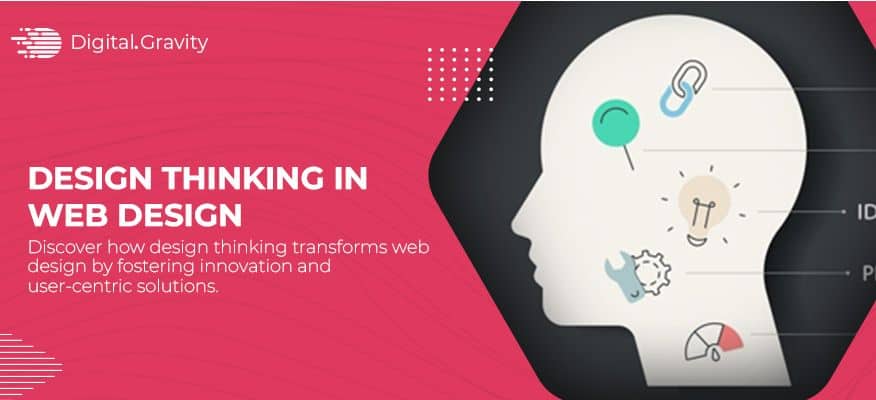Design Thinking in Web Design
The requirement for user experience is still increasing, so incorporating this to competition is more standardized and more in trend now. The idea is to improve the experience design through the method called Design Thinking Framework.
Design Thinking is not a word or a cool trend in the web design process; it encapsulates a strong philosophy and an empathetic approach, starting with understanding and telling your business to a person who interfaces.
Thus, this human-centered design thinking assists you in the analysis of multifaceted issues or situations, ordinary tasks, and, contrary to expectations, strategies to improve the UX of your website design.
This piece is for you if you are keen to consider the possibilities of website development and applying design thinking methodology.
What is Design Thinking?
Design Thinking is a way to solve problems by understanding the person who will use the solution, questioning what we think we know, and finding new ways to solve problems. It’s about thinking like a beginner, asking questions that don’t have just one answer, and always thinking about what the person who will use the solution needs. It’s about finding a balance between using our characters and thinking logically, being creative, and using data by exploring new ideas and making them happen.
The Design Thinking Process
At the heart of Design Thinking lies a robust process, a sequence of steps that form a repeatable model for problem-solving. Each step informs the next, leading to user-centric solutions. Here, we explore this journey with a detailed look at each step and its significance.
1- Empathize
The first thing in the Design Thinking Process is about really understanding the problems that people have. It means forgetting what we think we know and looking at things in a new way. Ways to do this could be talking to people, watching how they do things, and really getting into their world.
For example, if you were making an app to help older people with their grocery shopping, you might watch them shop or even go shopping with them to understand their problems and what they like better.
2- Define
After you have learned a lot about the people who will be using your product, the next thing to do is to figure out exactly what they need and what issues they are facing. This step is really important for making sure you understand the problem well.
For example, you might say that the problem is: “Older people have a hard time using technology and need an easy app to help them buy groceries.”
3- Ideate
Now we’re at the stage where we start coming up with creative solutions to the problem. In this stage, any idea is okay, even if it seems a little crazy. The idea is to think of all the different ways we could solve the problem.
For example, we could think about things like shopping lists that you can talk to, getting personalized recommendations for groceries, or using virtual reality to go shopping.
4- Prototype
The good ideas from the planning phase are now made into real examples. These are basic and not expensive versions of the product that help you look into the solutions and if they will work.
For the grocery app, examples might include a series of basic drawings or a model of the app that you can click through.
5- Test
The next thing to do is to try out the sample versions of your ideas with the people who will use them. This is how you find out what works, what doesn’t, and how you can make your solution better. After getting feedback from older people, you might make changes to your app, like making it simpler or improving how it responds to voice commands.
Every part of the Design Thinking Process step is important for solving problems. It’s not just about getting to the end; it’s about the whole process—understanding the users, figuring out what they need, coming up with new ideas, making sample versions, and always making the solution better based on what the users say. This process is why Design Thinking is such a useful way to improve how user experiences feel.
Why Design Thinking Process Matters in Web Design
Design Thinking helps web designers create user-friendly websites by placing a strong emphasis on understanding user needs and behaviors through research and empathy, allowing them to design solutions that directly address those needs, iteratively test and refine their designs based on user feedback, and ultimately create intuitive interfaces that are easy to navigate and interact with, leading to a positive user experience.
Key Points About How Design Thinking Contributes to User-Friendly Website Design.
– Putting The User First
Design Thinking involves understanding the user’s requirements and demands in the development of a website.
– Making Improvements Step By Step
Design Thinking entails creating and prototyping the website multiple times with the aim of understanding which design option is likely to yield the best results according to the users.
– Understanding Users’ Feelings
This is because designers elicit such information from the users through conversation, questions and observation in order to arrive at a better decision regarding the design.
– Trying Out Ideas
Web designers build prototypes in order to know whether users understand those fictional models and correct mistakes, if any, before launching the final models.
– Testing And Getting Advice
During this design thinking stage, it is recommended that users try to use the website to identify areas that require enhancement and ensure that it is easy to use for target groups.
The Benefits of Design Thinking Methodology
Now that you’ve had a refresher course in what Design Thinking is, let’s take a look at what really matters — how Design Thinking can help you design and develop better websites.
1- Gain a Better Understanding of the Client and Their Customers
We’ve talked about how the design process isn’t straightforward and teams often move back and forth between different stages. But it always begins with understanding the customer’s perspective. When we talk about understanding the client’s business model and objectives, the first stage isn’t about understanding the client at all. It’s about understanding the client’s customer.
By doing this, designers and developers can better understand what the user needs and wants from the website. The more you can think like the customer and understand their needs, the easier it will be to design and build a site that meets those needs. If the client knows how to write a web design brief, they can provide this customer information for you.
Once you have a clear understanding of the customer, you can start designing and developing. Every decision in the process should be aimed at meeting customer needs and wants in the best way possible.
So, how can companies gather this information? They can start by conducting thorough interviews with the client. Most clients have a good understanding of who their customer is. They have brand personas and a target demographic and know what their customer likes and dislike.
Take some time to understand the customer by asking the client for direct feedback on who their customer is. While this information might be available in their style guide, hearing it directly from them can be more impactful.
You can also research competitor websites to see how your client’s competition is addressing their customers’ concerns. Putting yourself in the customer’s shoes and visiting competitor sites is a great way to understand their needs and see where the competition may be falling short in providing the experience they’re looking for.
2- Encourage Creativity
The first step encourages being creative, which includes finding creative ways to solve problems and overcoming obstacles you may encounter. It makes you think about these obstacles and come up with a plan to deal with them. This leads to providing more and more innovative solutions for a better user experience.
Design Thinking requires you to stay open-minded and creative throughout the process, which helps prevent you from being limited by your own experience and expertise.
The longer you work in a particular job, the easier it is to feel like you know everything about it. You might think you’ve already found all the best solutions with previous clients, but you could be mistaken. There is always room to grow, no matter how good you are at your job.
Don’t just rely on your experience from past projects or use the same approach over and over just because it has worked before.
Whether you’re new to web development or the most experienced member of the design team, challenge your creativity, think differently, and consider that a new approach might be better than the ones you’ve used before.
If you only look at a project from a design or development perspective, you’ll limit the possibilities. Consider the project from the user’s point of view to better understand what the customer needs from the site.
3- Challenge Assumptions
Maybe you think you know the best way to make a website for a client, but do you really? Design Thinking helps you challenge your assumptions and think of new ways to solve problems. It’s important to not get stuck doing things the same way every time. By trying new approaches, you might discover better results than you thought possible.
Designing and developing a website using the same old methods can keep you from being creative. It’s important to keep in mind that your client’s customers are people with changing needs. Design Thinking can help you find better solutions as these needs change.
4- Meet and Exceed Client Goals
Designers and developers want to make their clients and stakeholders happy. To do this, they create sample versions of the website and test them. This helps them make sure the website works well and meets the needs of the people who will use it.
It’s important to test the website early on and throughout the design process. This way, any issues can be fixed quickly, and the final website can be delivered on time or even earlier.
Testing with your team is different from testing with clients. It’s best to make the testing process simple and easy for clients, so they can give feedback quickly. Clients and their customers don’t need any technical skills to give feedback on the website. They can simply click on parts of the website and leave their comments.
5- Make the Client’s Website Stand Out from the Competition
The process of Design Thinking is not straightforward. You have to keep thinking about how people feel and coming up with ideas throughout the process. This helps make the design of your website better and makes sure it meets the needs of the people who will use it.
As a web designer or developer, you’re not just making a website for your client. You’re making it for their customers. If the website doesn’t look good or work well, the customers will leave and go to a different website that’s better.
Do all websites use the Design Thinking Methodology?
No, not all websites use Design Thinking. But if you want to make the best website, assume that all the other websites you’re competing with have been made with the best design ideas.
If you combine Design Thinking with good testing and checking, you can make a website that your client and their customers will love. It’s a win for everyone!
Real-World Applications of Design Thinking in Web Design
Companies like Digital Gravity’s design team understand that, in design, form does not solely follow function but is a way to address factors. Among the methods used to solve those problems, the most efficient one is Design Thinking.
By positioning users at the core of the web design process, such an approach transforms this concept into a strategic one and transforms the process into an good one.
You will learn how Design Thinking could be used in web design, changing the perception of how people use and experience websites and how companies develop their business online.
1- Understanding Users Deeply
The first phase of Design Thinking is to try to understand the client and to think as he does. In web design, this translates to having to take time and look into what it is the user wants and requires. When we began a recent project, our first task was to gather as much user data as possible; Personas, Customer Journey Maps, Empathy Maps, Feedback, and Analytics.
Engaging with the data meant that we focused on their pains, wants, and the work they had to do. For example, the audience complained of an unresponsive site and the inability to locate products from one page to the next. Awareness of this pain sets the platform for the following step of the process.
2- Pinpoint the Problem
Empathy helps to determine what can be hard or uncomfortable for the user. Some common pain points of users identified in our project included problems in product search and frustration stemming from out-of-date imagery and layout interactivity.
With the problem clearly defined, we posed a critical question: In what ways could we improve the way that people are able to locate products?
However, as mentioned earlier, making the problem line is significant for providing focus to the whole design process. It makes it possible to drive each action going forward by solving a real user problem rather than trying to guess what seems to be.
3- Offer the Solutions
After analyzing the problem, it is time to ideas—to generate and conceptualize solutions. Ideation should not be a process that identifies an idea but an option for looking for several solutions.
We started with a hypothesis: Enhancing the website header would make it easier for users to find products. Therefore, to investigate this hypothesis, we performed experiential evaluations, looked at competitor sites, and explored BIHs.
We combined wireframes and flow sketches to design and test numerous concepts. This approach allows free thinking but keeps one’s eyes on the ball or the problem that has been formulated at this stage.
4- Bringing Ideas to Life
People rarely dream big; they dream big, but they don’t put it into practice until they brainstorm and come up with something tangible that may, in most cases, be realizable. In the case of the user interface design and high-fidelity, clickable prototype, we worked with Adobe XD at Digital Gravity.
Prototyping enabled stakeholders to provide feedback on the proposed experience as they came across the models.
Prototypes make ideas come alive by turning their layouts and designs into tangible objects that people can touch. By providing counterparts, the prototype of the idea allows the development of the necessary solution to be completed without high risks and significantly shortens the terms.
5- Validation Through Feedback
The last phase of Design Thinking is the implementation phase or the phase of testing. Testing helps to make sure that the solution we are working on is suitable for the users that it should serve. Our first scenario was to perform an A/B test of the new header against the current state of the redesign suggestion.
The results were clear: The header change increased sales and reduced the number of clicks between the header and purchase. Automated testing also supported our guess and confirmed that we had developed the proper solution to the problem.
Challenges of Implementing Design Thinking in Web Design
While working with Design Thinking in web design, you might face challenges, for instance, insufficient user research, difficulty adapting to non-linear processes, bad collaboration between teams, and struggling to balance creative ideation with technical, etc. Let’s go into depth of the challenges of Design Thinking.
Breakdown of Challenges
1- User Research Issues
Research is the first you could face in your while dealing with design things. You can lack in conducting the in-depth research to understand user needs and pain points. As a result, you would lead to potential bias in the design.
2- Organizational Culture Barriers
As a Web Design Agency Dubai, you can also struggle with organizational culture barriers, which can lead to aligning Design Thinking with existing company processes and decision-making structures.
3- Issues with Team Collaboration
Not working well together with different teams like designers, developers, business people, and others. Finding it tough to share user insights and design ideas with everyone.
4- Technical Problems
Trying to balance creative design ideas with the technical limits of the web platform. Forgetting about the needs of people with disabilities during the design process.
5- Other Issues
Getting too attached to initial ideas and not being able to let go of concepts that aren’t user-friendly. Your team might lack expertise in Design Thinking, which leads to misunderstandings about the process.
How You Can Overcome These Challenges
Now, you know about the challenges that you might face with this. But how would you overcome these? Read on; we have curated the right approach for you.
1- Prioritize User Research
For research you or your team must opt for comprehensive research to apprehend the user needs, behaviors, and pain points.
2- Ping-up Collaboration
You may try to streamline a cross – functional teams to work together in the whole design process.
3- Educate Stakeholders
Try to communicate everything in a clear way to your clients- this will not only help you with Design Thinking but also better decision making.
4- Hold Iteration
Go with the multiple prototyping and testing to get a revised version of your design based on your feedback.
5- Creating Design Thinking Skills
Don’t forget to train your team about the Design Thinking Process and significant practices.
6- Make Some Clear Goals
Consider defining the specific objectives for each Design Thinking Process to ensure it matches your business needs.
Conclusion
Implementing the Design Thinking process can help revolutionize your web development strategy. With a better understanding of your users, define some clear problems, ideate creative solutions and prototypes, and test with its response integration. By opting for and implementing this approach, you can easily develop a website that is not only visually appealing but also highly functional and user-centered.
So, if you want to transform your web development approach, opt for a web design agency in Dubai. Explore our options at Digital Gravity and discover the transformative power of Design Thinking today.
FAQs
How Does Design Thinking Help Designers?
Design Thinking is one of the innovative approaches that helps designers create a design solution for the end users. This not only communicates valuable skills but also enhance your career.
How Do You Practice Design Thinking?
Here are the 5 steps of the Design Thinking Process, which can get you a dependable design.
Stage 1: Empathize—Research Your Users’ Needs.
Stage 2: Define—State Your Users’ Needs and Problems.
Stage 3: Ideate—Challenge Assumptions and Create Ideas.
Stage 4: Prototype—Start to Create Solutions.
Stage 5: Test—Try Your Solutions Out.
When should Design Thinking be used?
Design is considered to sort out every complex challenge you might face while creating a design. This helps you to understand the problem and understand the solution.
Why do people use Design Thinking?
Design Thinking can get you something out of the box, and then your thinking. People who use this Design Thinking methodology step on the chance to do some new things and solve more problems than you think.
How many companies use Design Thinking?
In fact, 75% of organizations self-report that they are engaged in Design Thinking. Companies may be applying the approach but are any of them actually seeing results?




